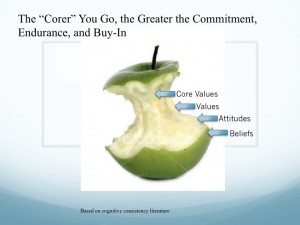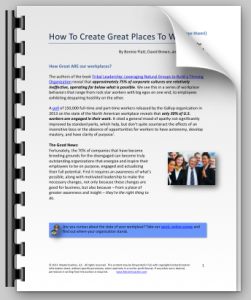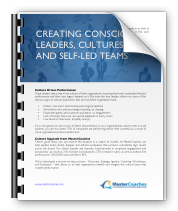Bringing up the notion of values, and more importantly, core values, is always an interesting conversation with clients. I hear a whole range of comments from c-suite executives.
- What do values have to do with running a business?
- We did that already at an offsite and it was fun while it lasted, but eventually we went back to work and were back to business as usual.
- Why bother, no one pays attention after a few weeks anyway.
The list goes on; I’m sure you’re familiar with the conversation. Recently, however, a client’s experience (a Chief Financial Officer) really encapsulated the whole point.
A few months ago his company’s senior leadership team did an offsite with a trainer from another company. They came up with “the company values” among other things like a vision and various goals and objectives. The values were: Integrity, Innovation, Respect, Candor, Employee Development, and High Performance.Overall, they felt it was a fruitful experience. The team got
energized and individually started working earnestly on their goals. It sounded like a typical offsite experience and it did seem to get these executives thinking differently, and more intentionally, about their company.
Although I had introduced my client earlier to the Tribal Leadership methodology, he felt at the time that the group wasn’t ready yet for such a departure from the norm. In fact, he was a pleasantly surprised that they even chose to do the offsite. Satisfied that was a good first step, he went forward with renewed energy.
Then something out of the blue happened. His comptroller resigned. The comptroller cited his longstanding feeling that the firm had neglected him in several ways, including compensation and a lack of regard for his professional
development. Clearly at odds with Integrity, Innovation, Respect, Candor, Employee Development, and High Performance introduced months earlier, this was a stunning indictment of that values exercise. And it wasn’t simply because the “roll out” of these values occurred after much of the damage to this employee had been done. It had continued afterwards, reflected in neglecting to fully remediate the concerns even after the resignation was submitted.
Damage control by the CFO kept the comptroller on, although the long-term trajectory remains to be seen. But the fact that they hadn’t been walking their talk became painfully clear. The truth is that if the above had been CORE values, none of these behaviors subsequent to the offsite would’ve occurred. In cultures aligned with core values, the core values direct decisions and actions naturally, almost literally a no-brainer (thinking not required – it’s at your core).
This brings us to the critical distinctions between non-core values and core values, as well as weaker statements like beliefs and attitudes. Examples and definitions:
Belief (statement of opinion): “We believe great customer service is the key to our success.”
Attitude (predisposition to act in a certain way): “We rise to every challenge.”
Non-Core Value (a principle that is important): “We value people’s work-life balance.”
- Core Values:
- “Principles that will cause you pain, but that if you don’t implement, will erode your integrity.” (Jerry Porras, co-author of Built to Last, in an interview in 2007.)
- “Principles without which, life isn’t worth living.” (Research conclusion published in Tribal Leadership.)
- “Guiding principles that make impossibly complex decisions easy.” (Gordon Binder, former CEO of Amgen, in an interview in 2007.) courtesy of CultureSynch
On one hand, core values are really at the core of who we are. We have visceral reactions when we don’t act in alignment with them. In some ways we don’t even notice our core values because they are just so much a part of who we are. When that transparency is interrupted by a violation, it hits us in the gut and is hard to ignore.
Returning to my client’s situation, beyond not having drilled down enough to get to core values, there was another pitfall that came to light. Core values are not something leaders hand down from the mountain. The tribe or culture of a company consists of people who already have core values. The opportunity is to elicit the
core values that already exist, bring them out into the open, and integrate them with the purpose of the enterprise. Instead, many leaders focus on “getting buy-in” which feels like you’re being sold to. Ownership is forced, whereas coalescing the core values that are present in the culture is akin to working with ownership that already exists. Core values are pre-sold! When integrated with a compelling meaningful vision for the business, you have a powerful self-sustaining foundation for a whole different level of innovation, productivity and satisfaction.
Admittedly the CFO’s intuition was correct. His firm was not yet ready to have that conversation. As in all things you must begin where you are, at whatever cultural stage your organization is at. There are ways to assess that and concrete steps and strategies to upgrade the culture to the point where factors like core values are operating in alignment with the company’s mission and vision for their future. That’s a conversation we’re starting to have with my client’s company. It usually takes breakdowns to reveal where the breakthroughs can be had.
My hope is that this story will inspire you to start an inquiry into where you see your organization now and what it can aspire to be.
or
Contact us for a complimentary conversation around this topic.









Social Links